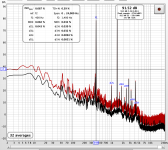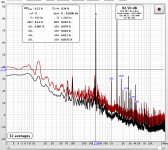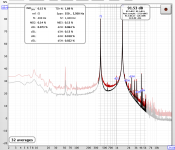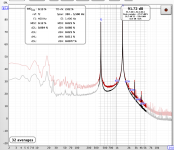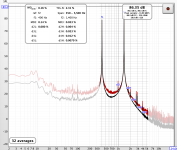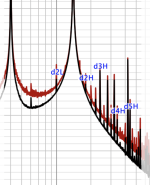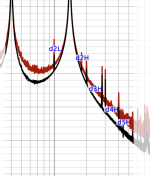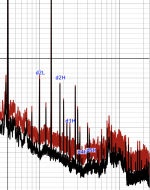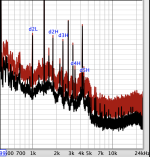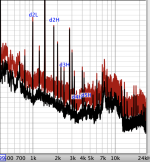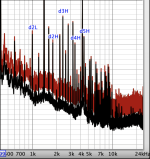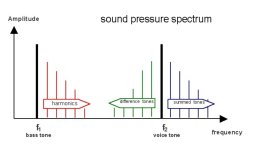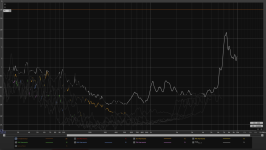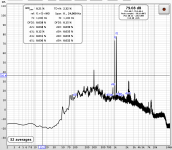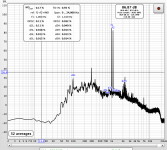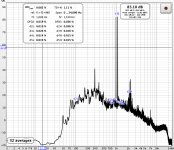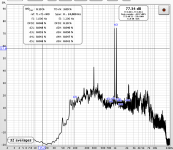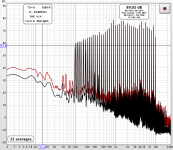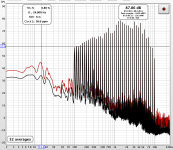Maybe in the next weeks, I need to find time to devote to measurements. I also want to understand why the PHL despite measuring quite well does not sound as good-I will try to break it in over the next few days so that I can eliminate any harshness due to the fact that it has never been used.Can you do some IMD comparaison?
6MCF200Nd looks like an incredible speaker.
I was surprised when I saw these measurements: they did not seem to correlate with my listening impressions. The beyma and the 18 sound that seem most pleasing to me are on opposite poles when at IMD. The SP6 which is the cheapest (about 1/8th the cost of the beyma!) and the worst in terms of sound characteristics excels in these measurements... Maybe I should have used a crossover filter and not measured midrange at full range? I measured residuals from the breakup that in real use would be filtered out by the crossover? Are the differences in distortion so small that they have no effect on listening characteristics? I do not have a clear idea of what IMD values are typical for a good midrange. I must admit that I have no experience with IMD measurements. Any suggestions are greatly appreciated.
Attachments
Last edited:
I tried to redo the measurements, same parameters as before but I considered the typical potential use range of midranges: I imposed a crossover filter LR48db 300-6000Hz. Band analyzed by REW for the purpose of IMD calculation 350-5500Hz. I am definitely still sampling some of the residuals of the membrane braekups but less than in the full-band measurements. As you can see the results seem more reasonable. There doesn't seem to be much difference in IMD emerging between speakers. It seems to me, after viewing some measurements of other loudspeakers, (please confirm if what I am saying makes sense) that all these midranges have very low IMD values, both measured fullrange and with crossover filtering.
Attachments
Last edited:
There is something, however, that does not make sense to me with REW's calculation of the IMD: look at image 1 regarding an enlargement of a part of the stage line graph and image 2 regarding the beyma: does it not seem to you that the stage line has a considerable amount more intermodulation bands than the beyma? Moreover, these bands are of significantly greater amplitude. This fact would not seem to emerge from the IMD % provided by REW. Do you have any suggestions?
Attachments
Last edited:
This phenomenon occurs in the same way in full-band measurements. It is very obvious. At a qualitative investigation of the full-band missures it would appear that the stage line is definitely more affected by intermodulation bands, followed by the PHL while the other three behave about equally well. This would be perfectly in line with my listening sensations. Any thoughts?
Attachments
Last edited:
Here some dual tone 60+1000Hz IMD measurement of a two very good mid woofer for a comparison.
https://www-justdiyit-com.translate..._sl=fr&_x_tr_tl=en&_x_tr_hl=sv&_x_tr_pto=wapp
Keep in mind that different parameters and different software were used so the measurements are not really comparable, nevertheless the measured IMD is almost 10 times that of the best of these midranges.
https://www-justdiyit-com.translate..._sl=fr&_x_tr_tl=en&_x_tr_hl=sv&_x_tr_pto=wapp
Keep in mind that different parameters and different software were used so the measurements are not really comparable, nevertheless the measured IMD is almost 10 times that of the best of these midranges.
I don't see that 2k peak on your measurements :

Found on https://www.usspeaker.com/beyma 6mcf200nd-1.htm
Thank you for your measurements. Would love to read more opinions about some experts here about this driver 🙂
Found on https://www.usspeaker.com/beyma 6mcf200nd-1.htm
Thank you for your measurements. Would love to read more opinions about some experts here about this driver 🙂
You are right!!! I was worried about that peak where the third harmonic overtook the second. I tried redoing the measurement several times but it doesn't show up in any of them. On closer inspection there is an increase in the second harmonic between 1000 and 2000Hz but no increase in the third harmonic. In addition, the peak I see barely exceeds 0.2 percent while the one you see on Beyma's site barely exceeds 1 percent. Conversely, the breakup in my measurements creates a much worse distortion peak than in the manufacturer's measurements. Also the frequency response is different but this is due to the lack of baffle in my measurement.
I do not have extensive experience in measurements, however I have read in some posts that often the measurements made with ARTA and with REW are quite different from each other, I guess the same thing happens with Kippel. I here used REW installed on a MacBook Pro, Minidsp umik1 with its calibration, class D amplifier based on IRS2092 (Wondom).
If any experts would like to give us an opinion it would be very interesting.
I do not have extensive experience in measurements, however I have read in some posts that often the measurements made with ARTA and with REW are quite different from each other, I guess the same thing happens with Kippel. I here used REW installed on a MacBook Pro, Minidsp umik1 with its calibration, class D amplifier based on IRS2092 (Wondom).
If any experts would like to give us an opinion it would be very interesting.
Attachments
Last edited:
To have a comparison with measurements made by other experts I replied the dual tone IMD showed here
https://www-justdiyit-com.translate..._sl=fr&_x_tr_tl=en&_x_tr_hl=sv&_x_tr_pto=wapp
for a couple of well regarded mid woofer.
Here the results
https://www-justdiyit-com.translate..._sl=fr&_x_tr_tl=en&_x_tr_hl=sv&_x_tr_pto=wapp
for a couple of well regarded mid woofer.
Here the results
Attachments
Hi Frankx
Very interesting drivers and test 😉
When measuring have you used a baffle?
I don't think it makes sense to do measurements without either a baffle or a closed box.
Standard would be something like this
https://www.diyaudio.com/community/threads/baffle-size-for-driver-testing.161195/
But this is probably also what you have been doing .... sorry if I didn't get it from the test.
For listening test a box sort of what you are heading for would make a lot of sense, and for sure quite matched freq response (eq) will be needed, as I think most people will be able to hear differences down to 0.5 db (I think it is much more difficult to hear the distortion difference). And you'll have to have a setup where you can really A/B the drivers by a switch .... if you need to change setup and cables etc. it will not be controlled enough to really get a good result ... and you will be biased on what is more expensive and looks the best 😉 .... we all are 🙂
It will also matter whether you are going to use DSP Xover or a passive Xover. For the later, the driver response is of course much more important, and some drivers will end up requiring a complex filter adding cost and complexity.
my 2 cent
/Baldin
Very interesting drivers and test 😉
When measuring have you used a baffle?
I don't think it makes sense to do measurements without either a baffle or a closed box.
Standard would be something like this
https://www.diyaudio.com/community/threads/baffle-size-for-driver-testing.161195/
But this is probably also what you have been doing .... sorry if I didn't get it from the test.
For listening test a box sort of what you are heading for would make a lot of sense, and for sure quite matched freq response (eq) will be needed, as I think most people will be able to hear differences down to 0.5 db (I think it is much more difficult to hear the distortion difference). And you'll have to have a setup where you can really A/B the drivers by a switch .... if you need to change setup and cables etc. it will not be controlled enough to really get a good result ... and you will be biased on what is more expensive and looks the best 😉 .... we all are 🙂
It will also matter whether you are going to use DSP Xover or a passive Xover. For the later, the driver response is of course much more important, and some drivers will end up requiring a complex filter adding cost and complexity.
my 2 cent
/Baldin
Hi Baldin, thank you for your suggestions.
You understood correctly: unfortunately I did not use a baffle. I am aware that the measurements in this way (especially the frequency response) make little sense but they are measurements that I egged up for myself and only later decided to post on the forum. At the moment I had neither time nor equipment to build a baffle. Perhaps I will have a way to do that later. The frequency response interests me relatively as these mids will go into a totally active 4-way system filtered through dsp.
For the listening test I did my best: equalized response via dsp (although I did not waste hours in perfecting the responses within 0.5db) and same sound chain. Fast switch without changing components. Missing the blind test (single or double whatever) but they were measurements that were not meant to have anything scientific, just to lead me to choose the best medium for my project. I also tried the complete chain of components (only 3-way for now, no subwoofer) changing only the midrange.
For now the 18 sound and especially the beyma are the ones that lead to a listening experience that most meets my criteria.
Obviously I am aware of the issues related to psychological bias and the needs for a truly scientific approach to listening (as a job I am a neuroscientist) but for my purposes (recreational) this would be out of my scope.
I would welcome advice if anyone has experience with large midrange, I am aware of the theory: the obvious limitations in breakup and directivity of a midrange of that size but sometimes theory does not explain everything! see what Troels says about 10' mids: http://www.troelsgravesen.dk/The-Loudspeaker.htm and also see how some manufacturers have continuous requests for HF drivers that show an (for us unacceptable) breakup peak around 15000hz despite the fact that they have new generation drivers for sale that are much better in this respect.
(around minute 1.04:00 ) Personal tastes are very variable and sometimes people chase a certain sound that is not always the most faithful. In my case for example I find that the emission surface matters a lot. I would be tempted to pick up the 18 sound 10NDA610 or the beyma 10 "MCF400ND to try and hear but the expense limits me quite a bit.
Thanks!
Franco
You understood correctly: unfortunately I did not use a baffle. I am aware that the measurements in this way (especially the frequency response) make little sense but they are measurements that I egged up for myself and only later decided to post on the forum. At the moment I had neither time nor equipment to build a baffle. Perhaps I will have a way to do that later. The frequency response interests me relatively as these mids will go into a totally active 4-way system filtered through dsp.
For the listening test I did my best: equalized response via dsp (although I did not waste hours in perfecting the responses within 0.5db) and same sound chain. Fast switch without changing components. Missing the blind test (single or double whatever) but they were measurements that were not meant to have anything scientific, just to lead me to choose the best medium for my project. I also tried the complete chain of components (only 3-way for now, no subwoofer) changing only the midrange.
For now the 18 sound and especially the beyma are the ones that lead to a listening experience that most meets my criteria.
Obviously I am aware of the issues related to psychological bias and the needs for a truly scientific approach to listening (as a job I am a neuroscientist) but for my purposes (recreational) this would be out of my scope.
I would welcome advice if anyone has experience with large midrange, I am aware of the theory: the obvious limitations in breakup and directivity of a midrange of that size but sometimes theory does not explain everything! see what Troels says about 10' mids: http://www.troelsgravesen.dk/The-Loudspeaker.htm and also see how some manufacturers have continuous requests for HF drivers that show an (for us unacceptable) breakup peak around 15000hz despite the fact that they have new generation drivers for sale that are much better in this respect.
Thanks!
Franco
Last edited:
Your initial measurements show quite some ‘noise’ probably caused by reflections or background noise. What is your setup and do you use averaging?
[Edit] aha, no baffle. Use a baffle, preferably with a fully closed back side. Otherwise these measurements are a bit useless.
[Edit] aha, no baffle. Use a baffle, preferably with a fully closed back side. Otherwise these measurements are a bit useless.
Hi Mark, I used averaging only in the IMD measures. The first measurements were done in a 6x7m room, REW, UMIK1 posited on axis 10cm from the driver. No average, 1M sweep lenght, 5ms window.
These measurements were made to compare some midranges with each other under the same conditions, not to obtain measurements whose frequency response is comparable with measurements made by others. Within this view they should be considered. The moment I can redo them with a baffle or a closed box I will do so but at the moment I am not atequipped to do so.
From what do you infer that my first measurements (which ones in particular?) are noisy? I didn't realize it but I am always interested in learning how to improve my measurements.
Franco
These measurements were made to compare some midranges with each other under the same conditions, not to obtain measurements whose frequency response is comparable with measurements made by others. Within this view they should be considered. The moment I can redo them with a baffle or a closed box I will do so but at the moment I am not atequipped to do so.
From what do you infer that my first measurements (which ones in particular?) are noisy? I didn't realize it but I am always interested in learning how to improve my measurements.
Franco
(EDIT): around minute 49.20Hi Baldin, thank you for your suggestions.
You understood correctly: unfortunately I did not use a baffle. I am aware that the measurements in this way (especially the frequency response) make little sense but they are measurements that I egged up for myself and only later decided to post on the forum. At the moment I had neither time nor equipment to build a baffle. Perhaps I will have a way to do that later. The frequency response interests me relatively as these mids will go into a totally active 4-way system filtered through dsp.
For the listening test I did my best: equalized response via dsp (although I did not waste hours in perfecting the responses within 0.5db) and same sound chain. Fast switch without changing components. Missing the blind test (single or double whatever) but they were measurements that were not meant to have anything scientific, just to lead me to choose the best medium for my project. I also tried the complete chain of components (only 3-way for now, no subwoofer) changing only the midrange.
For now the 18 sound and especially the beyma are the ones that lead to a listening experience that most meets my criteria.
Obviously I am aware of the issues related to psychological bias and the needs for a truly scientific approach to listening (as a job I am a neuroscientist) but for my purposes (recreational) this would be out of my scope.
I would welcome advice if anyone has experience with large midrange, I am aware of the theory: the obvious limitations in breakup and directivity of a midrange of that size but sometimes theory does not explain everything! see what Troels says about 10' mids: http://www.troelsgravesen.dk/The-Loudspeaker.htm and also see how some manufacturers have continuous requests for HF drivers that show an (for us unacceptable) breakup peak around 15000hz despite the fact that they have new generation drivers for sale that are much better in this respect.(around minute 1.04:00 ) Personal tastes are very variable and sometimes people chase a certain sound that is not always the most faithful. In my case for example I find that the emission surface matters a lot. I would be tempted to pick up the 18 sound 10NDA610 or the beyma 10 "MCF400ND to try and hear but the expense limits me quite a bit.
Thanks!
Franco
- Home
- Loudspeakers
- Multi-Way
- Beyma 6MCF200Nd measurements

